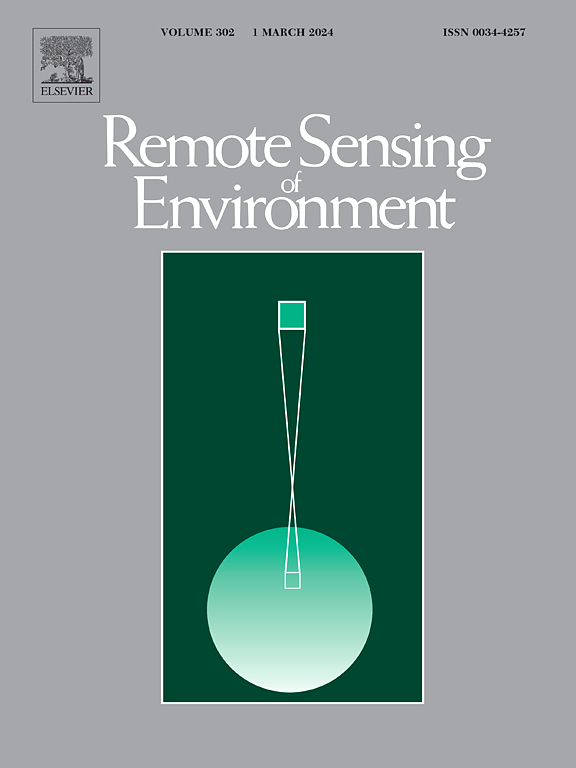A geostatistical approach to enhancing national forest biomass assessments with Earth Observation to aid climate policy needs
IF 11.1
1区 地球科学
Q1 ENVIRONMENTAL SCIENCES
引用次数: 0
Abstract
Earth Observation (EO) data can provide added value to nations’ assessments of vegetation aboveground biomass density (AGBD) with minimal additional costs. Yet, neither open access to global-scale EO datasets of vegetation heights or biomass, nor the availability of computational power, has proven sufficient for their wide uptake in climate policy-related assessments. Using Mexico as an example, one of the primary obstacles to enhancing their National Forest Inventory (NFI) with such global EO datasets is the lack of statistically defensible methodologies that do so, while addressing the nation’s existing reporting needs and gaps. In collaboration with the Comisión Nacional Forestal (CONAFOR), this study develops a geostatistical model that integrates vegetation height and AGBD estimates from NASA’s Global Ecosystem Dynamics Investigation (GEDI) and ESA’s Climate Change Initiative (CCI) with Mexico’s NFI to attain sub-national and geographically-explicit biomass predictions. The posited model includes spatially varying parameters, allowing flexibility to capture non-stationary relations between the EO-based covariates and NFI-estimated AGBD. Inference is conducted with Bayesian methods, allowing the computation of summary statistics, such as the standard deviations for single-location and area-wide predictions of AGBD. This enables the transparent disclosure and traceability of sources of uncertainty throughout the prediction approach. Results indicate strong model performance; the EO-based covariates explain 79% of the variance in NFI-estimated AGBD in a randomly withheld sample of 10% of observations and a heuristic root mean squared error (RMSE) of 21.55 Mg/ha. Approximately 96% of the observations falling within the 95% credible intervals of our predictions, with some systematic under-prediction observed at AGBD ranges of Mg/ha. To ease the operational uptake of the model for policy purposes, source code based in the ‘R’ language with the optional use of urban and (non)forest masks for AGBD predictions is released. It includes demonstrations for predicting AGBD in Mexico’s Natural Protected Areas, terrestrial ecological strata, and community forest management or payment for environmental services projects, which are commonly used delineations in its climate policy reports. For other nations considering the presented approach for policy purposes, the study discusses challenges concerning the use of EO-based covariates and the limitations of the model. It concludes with a broader call toward ensuring consistency in EO data streams, and prioritizing the co-development of EO-NFI integration approaches with nations in the future, thereby directly addressing their long-term climate policy needs.
利用地球观测加强国家森林生物量评估的地质统计学方法,以满足气候政策的需要
地球观测(EO)数据可以以最小的额外成本为各国对植被地上生物量密度(AGBD)的评估提供附加价值。然而,无论是开放获取植被高度或生物量的全球尺度EO数据集,还是计算能力的可用性,都不足以在与气候政策相关的评估中广泛采用它们。以墨西哥为例,利用此类全球生态数据集加强国家森林清查(NFI)的主要障碍之一是,在解决该国现有报告需求和差距的同时,缺乏统计上站得住脚的方法。与Comisión国家森林(CONAFOR)合作,本研究开发了一个地质统计模型,该模型整合了美国宇航局全球生态系统动力学调查(GEDI)和欧航局气候变化倡议(CCI)与墨西哥NFI的植被高度和AGBD估计,以获得次国家和地理上明确的生物量预测。假设的模型包括空间变化的参数,允许灵活地捕获基于eo的协变量和nfi估计的AGBD之间的非平稳关系。使用贝叶斯方法进行推断,可以计算汇总统计量,例如单位置和全区域AGBD预测的标准差。这使得整个预测方法的不确定性来源的透明披露和可追溯性成为可能。结果表明,模型性能较好;在随机保留的10%的观察样本中,基于生态系统的协变量解释了nfi估计的AGBD方差的79%,启发式均方根误差(RMSE)为21.55 Mg/ha。大约96%的观测值落在我们预测的95%可信区间内,在100毫克/公顷的AGBD范围内观察到一些系统的预测不足。为了便于政策目的对模型的操作吸收,发布了基于R语言的源代码,可选择使用城市和(非)森林遮罩进行AGBD预测。它包括预测墨西哥自然保护区、陆地生态层、社区森林管理或环境服务项目的AGBD的示范,这些都是墨西哥气候政策报告中常用的描述。对于考虑为政策目的提出的方法的其他国家,该研究讨论了有关使用基于eo的协变量的挑战和模型的局限性。最后,报告更广泛地呼吁确保观测数据流的一致性,并优先考虑未来与各国共同开发观测-国家金融机构一体化方法,从而直接满足其长期气候政策需求。
本文章由计算机程序翻译,如有差异,请以英文原文为准。
求助全文
约1分钟内获得全文
求助全文
来源期刊

Remote Sensing of Environment
环境科学-成像科学与照相技术
CiteScore
25.10
自引率
8.90%
发文量
455
审稿时长
53 days
期刊介绍:
Remote Sensing of Environment (RSE) serves the Earth observation community by disseminating results on the theory, science, applications, and technology that contribute to advancing the field of remote sensing. With a thoroughly interdisciplinary approach, RSE encompasses terrestrial, oceanic, and atmospheric sensing.
The journal emphasizes biophysical and quantitative approaches to remote sensing at local to global scales, covering a diverse range of applications and techniques.
RSE serves as a vital platform for the exchange of knowledge and advancements in the dynamic field of remote sensing.
 求助内容:
求助内容: 应助结果提醒方式:
应助结果提醒方式:


